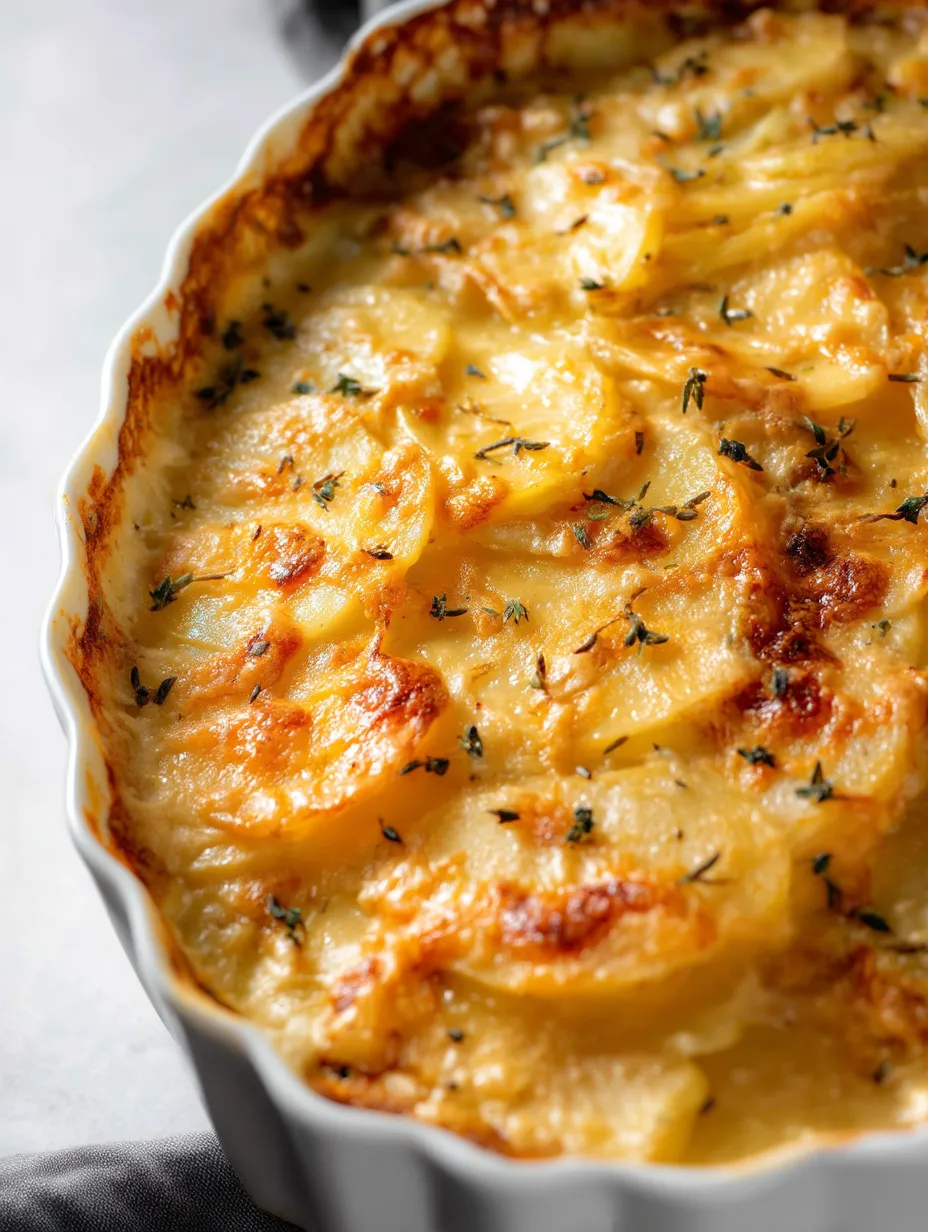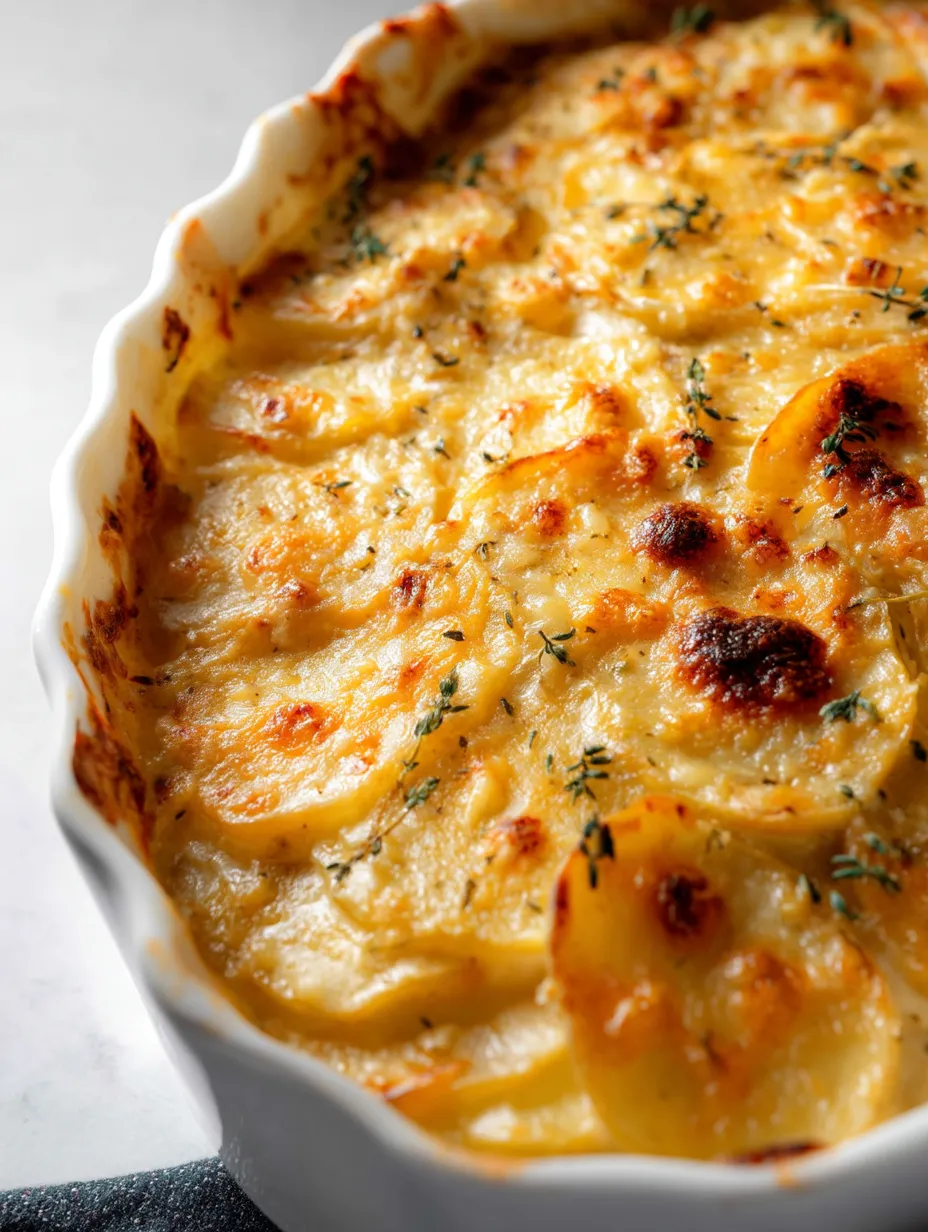 Pin it
Pin it
Layers of thinly sliced potatoes bathed in a rich, velvety sauce that bubbles around the edges as it bakes to golden perfection. This scalloped potato dish transforms humble ingredients into something truly special – tender potato slices nestled in a savory sauce with just the right amount of cheese to create that perfect balance of comfort and indulgence. The aroma that fills your kitchen as it bakes signals that something extraordinary is happening in your oven, drawing everyone to gather around the table in anticipation of that first heavenly bite.
I made these scalloped potatoes for my in-laws' anniversary dinner last month, and my father-in-law – who typically offers polite but minimal comments about food – asked for the recipe before dessert was even served. My sister attempted a similar dish for Thanksgiving years ago that turned out grainy and separated; after trying mine, she immediately pulled me aside to find out the "secret" to that perfectly smooth sauce. Even my nephew, who normally pushes potatoes around his plate, helped himself to seconds and asked if we could have the "fancy potatoes" again soon.
Essential Ingredients
- Yukon Gold potatoes: Their naturally buttery flavor and waxy texture hold their shape perfectly while becoming tender without falling apart; look for medium-sized potatoes with smooth, thin skins. 3 pounds (about 6-7 medium potatoes) needed.
- Sharp cheddar cheese: Provides the perfect balance of flavor and meltability; freshly grated from a block melts much more smoothly than pre-shredded varieties coated with anti-caking agents. 1 cup needed.
- Fresh thyme: Contributes an earthy, subtle herb flavor that cuts through the richness of the sauce; choose bunches with vibrant green leaves and flexible stems. ½ teaspoon dried thyme needed (or 1 teaspoon fresh thyme leaves for garnish).
- All-purpose flour: Creates the roux that thickens your sauce to silky perfection; measuring accurately is crucial as too much creates a gummy texture. 6 tablespoons needed.
- Whole milk: Provides creamy richness that forms the base of your sauce; the fat content is important for proper thickening and mouthfeel. 2 cups needed.
 Pin it
Pin it
Step-by-Step Cooking Instructions
- Step 1:
- Prepare your potatoes with care – Peel 3 pounds of Yukon Gold potatoes and rinse under cold water to remove excess starch. Slice into ⅛-inch thick rounds using a mandolin or sharp knife. Place slices in cold water to prevent browning, then drain and pat dry with kitchen towels to remove excess moisture.
- Step 2:
- Create the flavor foundation – In a large saucepan over medium-low heat, melt 4 tablespoons butter until foaming but not browning. Add ½ cup finely diced onion and cook for 3-4 minutes until translucent. Add 1 teaspoon minced garlic and cook for 30 seconds until fragrant, avoiding browning.
- Step 3:
- Master the perfect roux – Sprinkle 6 tablespoons all-purpose flour over the butter-onion mixture and whisk constantly for 2 minutes to cook out the raw flour taste. The mixture will resemble wet sand.
- Step 4:
- Develop a silky sauce – Reduce heat to low and slowly add 1 cup chicken broth, whisking to prevent lumps. Gradually pour in 2 cups whole milk in a steady stream, whisking constantly. Increase heat to medium and bring to a gentle boil, stirring until thickened (3-5 minutes). The sauce should coat the back of a spoon.
- Step 5:
- Enrich with cheese and seasonings – Remove from heat and season with 1 teaspoon salt, ½ teaspoon black pepper, and ½ teaspoon dried thyme. Stir in 1 cup grated sharp cheddar cheese until melted and smooth. Adjust seasonings to taste.
- Step 6:
- Assemble with intention – Spray a 9×13-inch baking dish with non-stick spray. Layer half the potato slices, slightly overlapping. Season lightly with salt and pepper, then pour half the cheese sauce over, spreading evenly. Repeat with remaining potatoes, salt, pepper, and sauce, ensuring potatoes are fully covered.
- Step 7:
- Bake with patience – Cover tightly with foil and bake at 350°F (175°C) for 45 minutes. Remove foil and bake for an additional 30 minutes until bubbling and golden brown with caramelized edges.
- Step 8:
- Rest before serving – Let rest for 15 minutes to allow the sauce to set. Garnish with 1 teaspoon fresh thyme leaves before serving.
I learned the importance of patience with scalloped potatoes after a memorable kitchen disaster at my first dinner party. Eager to impress, I rushed the cooking time and served potatoes that were beautifully golden on top but still crunchy inside. My grandmother later shared her secret of the two-stage baking method and proper resting time, completely transforming my results. My husband claims these potatoes are the reason he proposed – apparently, I made them for him on our third date, and he says he knew anyone who could make potatoes taste that good was someone he wanted to keep around forever.
Perfect Pairings for Scalloped Potatoes
While delicious enough to stand alone, scalloped potatoes shine brightest when paired thoughtfully with complementary dishes. For a special dinner, serve alongside a roasted beef tenderloin – the robust flavors of the meat complement the creamy richness of the potatoes.
For a lighter option, pair with herb-roasted chicken and roasted asparagus or Brussels sprouts. The bright, green flavor of the vegetables cuts through the richness. A crisp green salad with vinaigrette also balances the creamy potatoes.
Make-Ahead Magic
Prepare the dish up to the baking point, cover tightly with plastic wrap, and refrigerate for up to three days. Bake as directed, adding 15 minutes to the covered baking time.
For reheating, fully bake, cool completely, then refrigerate. Reheat covered with foil in a 325°F oven for 30 minutes until warmed through.
 Pin it
Pin it
Troubleshooting Common Issues
If the sauce curdles, it was heated too quickly. Add milk gradually and keep heat moderate. If potatoes aren't tender, slices may be too thick; cover and bake longer until a knife slides through easily.
I've been making these scalloped potatoes for nearly every holiday gathering for the past decade, and they've become something of a signature dish that family members request by name. What I love most about this recipe is how it transforms humble ingredients into something that feels special enough for celebrations yet comforting enough for Sunday dinner. There's something magical about the way the cream sauce weaves between the potato slices, creating distinct layers that manage to hold together when served yet melt in your mouth with each bite. Over the years, I've learned that while the ingredients are simple, it's the technique and patience that elevate this dish from good to unforgettable. When I see people closing their eyes with that first bite, I know the extra effort was absolutely worth it.
Frequently Asked Questions
- → Can I make scalloped potatoes ahead of time?
- Yes! Assemble the dish completely, cover with foil and refrigerate for up to 24 hours. When ready to bake, let it sit at room temperature for 30 minutes, then bake as directed, adding about 15 minutes to the covered baking time.
- → What's the difference between scalloped potatoes and au gratin potatoes?
- Traditionally, scalloped potatoes are made with a cream sauce while au gratin potatoes have cheese between the layers and breadcrumbs on top. However, many modern scalloped potato recipes (like this one) include cheese in the sauce.
- → Why are my scalloped potatoes still hard after baking?
- This usually happens when the potatoes are sliced too thick or the dish wasn't baked long enough. Make sure to slice potatoes 1/8-inch thin using a mandolin if possible, and test for doneness by inserting a fork before removing from the oven.
- → Can I freeze scalloped potatoes?
- Yes, you can freeze them either before or after baking. If freezing before baking, let thaw completely in the refrigerator before baking. If freezing after baking, let thaw and reheat covered at 350°F until hot throughout.
- → What can I serve with scalloped potatoes?
- Scalloped potatoes pair beautifully with ham, roast beef, meatloaf, roast chicken, or turkey. Add a green vegetable like roasted asparagus, green beans, or a simple salad to complete the meal.
